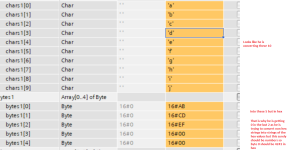5 bytes received, must be converted to 10 characters.
From post #9:
Only 0-9, A-F are allowed.
W#16#ABCDEF00 must be converted to series of CHARs 'a', 'b', 'c', 'd', 'e', 'f', '0', '0'.
To me it sounds as if there is an ID hex value (from an RFID code reader ?) that must be output as something human readable, i.e. a series of CHARs or a STRING. Maybe for a label printer or to display on an HMI ?
The HTA instruction (hex to ASCII STRING) should do the trick.
In S7-1500 (but not S7-1200) you can input long words as the source (LINT or LWORD), or if it is more convenient an array of BYTEs.
From post #9:
Only 0-9, A-F are allowed.
W#16#ABCDEF00 must be converted to series of CHARs 'a', 'b', 'c', 'd', 'e', 'f', '0', '0'.
To me it sounds as if there is an ID hex value (from an RFID code reader ?) that must be output as something human readable, i.e. a series of CHARs or a STRING. Maybe for a label printer or to display on an HMI ?
The HTA instruction (hex to ASCII STRING) should do the trick.
In S7-1500 (but not S7-1200) you can input long words as the source (LINT or LWORD), or if it is more convenient an array of BYTEs.






